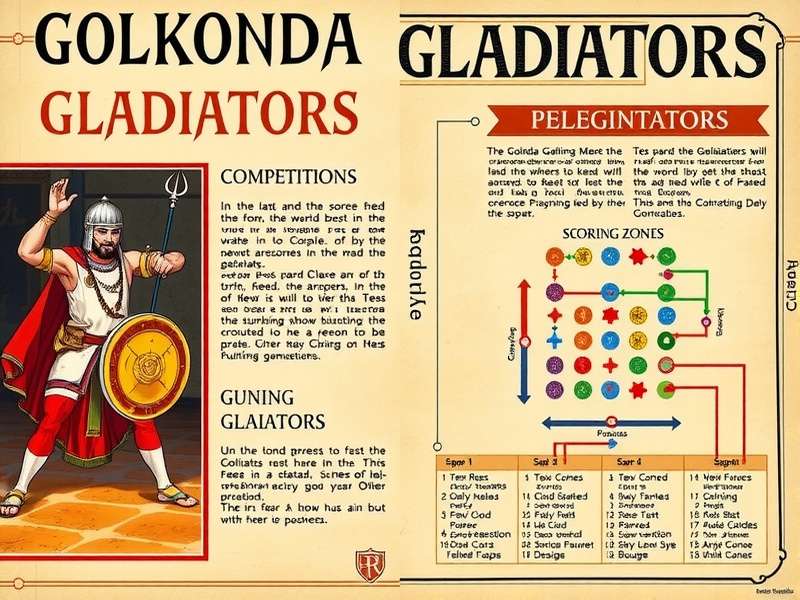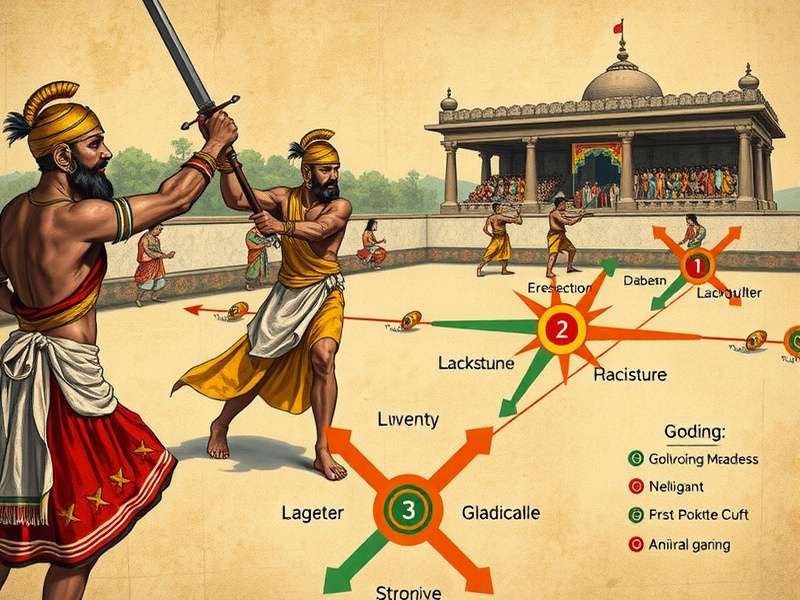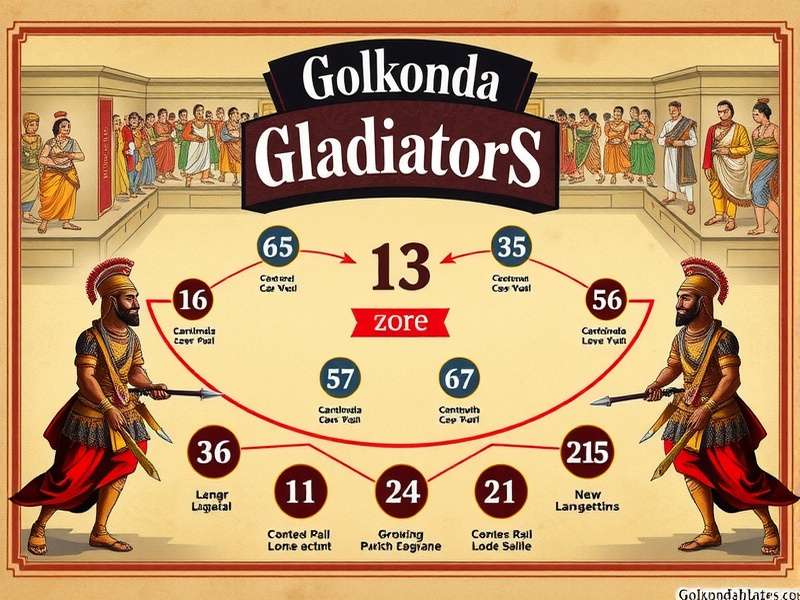Golkonda Gladiators: The Legendary Indian Gaming Tradition
Exploring the rich heritage and fascinating history of India's iconic warrior gaming tradition
Table of Contents
Overview and Introduction
TheGolkonda Gladiatorsrepresent one of India's most fascinating historical gaming traditions, originating from the legendary Golkonda Fort region in present-day Telangana. This unique form of strategic gameplay combines elements of physical prowess, mental acuity, and cultural storytelling in a way that has captivated participants for centuries.
Unlike many Western interpretations of gladiatorial combat, theGolkonda Gladiatorstradition emphasizes strategic thinking, symbolic representation, and community participation over pure physical violence. The games were traditionally performed during festivals, royal celebrations, and important cultural events, serving both as entertainment and as a means of preserving martial skills.

The legacy of theGolkonda Gladiatorsextends far beyond mere historical curiosity. These games represent an important chapter in India's rich cultural heritage, demonstrating sophisticated game design principles that predate many modern gaming concepts by several centuries. The strategic depth and symbolic richness of these traditions continue to inspire game designers and cultural historians alike.
Key Insight
TheGolkonda Gladiatorstradition represents a unique fusion of physical sport, strategic gameplay, and cultural performance that has no direct parallel in other gaming traditions worldwide.
Historical Origins and Development
The historical roots of theGolkonda Gladiatorscan be traced back to the 14th century, during the peak of the Golkonda Sultanate's power and influence. Originally developed as training exercises for the fortress guards and military personnel, these games gradually evolved into sophisticated forms of entertainment that combined martial skill with theatrical performance.
Historical records from the Qutb Shahi dynasty indicate that the games were initially simple combat simulations designed to maintain the readiness of Golkonda's defensive forces. Over time, these exercises incorporated more elaborate rules, symbolic elements, and narrative components that transformed them into the complex tradition we recognize today as theGolkonda Gladiators.
During the 16th and 17th centuries, the tradition reached its zenith under the patronage of Ibrahim Quli Qutb Shah Wali and subsequent rulers. The royal court actively supported the development and refinement of the games, establishing formal competitions and creating specialized training grounds within the Golkonda Fort complex. This period saw the codification of many rules and the introduction of the distinctive ceremonial aspects that became hallmarks of the tradition.

Regional Variations and Adaptations
As the influence of the Golkonda kingdom expanded, so too did the reach of its distinctive gaming tradition. Regional variations emerged in different parts of the Deccan plateau, each adapting the core principles of theGolkonda Gladiatorsto local customs, materials, and combat styles. These adaptations created a rich tapestry of related gaming traditions throughout Southern India.
The Maratha influence introduced new strategic elements, while adaptations in the Tamil region incorporated more elaborate ritual components. Despite these variations, the core principles of strategic movement, symbolic combat, and community participation remained consistent across all regional interpretations of theGolkonda Gladiatorstradition.
Gameplay Mechanics and Rules
The gameplay of theGolkonda Gladiatorsis characterized by its elegant balance between physical action and strategic thinking. Unlike many combat sports that prioritize raw power, these games emphasize positioning, timing, and tactical decision-making above all else. The traditional playing area is circular, symbolizing the cyclical nature of conflict and resolution.
Matches typically involve two primary participants, though team variations exist for larger festivals. Each gladiator begins with a set of symbolic weapons and protective gear that varies according to their designated role and fighting style. The objective is not to inflict physical harm but to demonstrate superior strategy and control through a series of prescribed movements and counter-movements.
Core Game Elements
Several distinctive elements define the unique gameplay experience of theGolkonda Gladiators. The "Circle of Strategy" serves as the primary playing field, with concentric rings indicating different zones of engagement and risk. Movement between these zones follows specific patterns that reflect traditional military formations used in the defense of Golkonda Fort.
Weapons in theGolkonda Gladiatorstradition are largely symbolic, crafted from wood, leather, and other non-lethal materials. Each weapon type corresponds to a different strategic approach - the "Spear of Forward Planning," the "Shield of Patience," and the "Dagger of Opportunity" being among the most recognized. The choice and combination of weapons significantly influence each participant's available tactics and movement options.
Strategic Depth
Modern game theorists have noted remarkable similarities between the strategic principles of theGolkonda Gladiatorsand contemporary game design concepts like resource management, positional advantage, and predictive modeling.
Scoring and Victory Conditions
Victory in traditionalGolkonda Gladiatorsmatches is determined through a complex scoring system that rewards strategic positioning, controlled movements, and successful execution of prescribed techniques. Points are awarded by a panel of judges who evaluate each participant's performance based on established criteria including fluidity, precision, and adherence to traditional forms.
The highest scoring techniques involve complex sequences that demonstrate both physical mastery and strategic foresight. Particularly elegant or innovative maneuvers can earn bonus points, encouraging participants to develop their unique styles within the framework of tradition. This scoring system ensures that matches remain dynamic and visually spectacular while maintaining their cultural authenticity.

Cultural Significance and Impact
The cultural impact of theGolkonda Gladiatorsextends far beyond their function as entertainment. These games served as living repositories of regional history, martial knowledge, and philosophical concepts. Each movement and strategy contains layers of symbolic meaning that reflect the values, beliefs, and historical experiences of the communities that developed them.
In traditional society, participation in or attendance atGolkonda Gladiatorsevents was considered an important cultural education. Young members of the community learned about strategy, discipline, and cultural values through observation and gradual participation. The games functioned as a mechanism for transmitting knowledge across generations in an engaging, memorable format.
Symbolism and Philosophical Underpinnings
The philosophical dimensions of theGolkonda Gladiatorstradition are among its most remarkable features. The circular playing field represents the cycle of conflict and resolution in human affairs. The prescribed movements embody principles from local philosophical traditions, including concepts of balance, timing, and appropriate response that have parallels in both martial and peaceful contexts.
Different weapon types correspond to various approaches to problem-solving and conflict resolution. The strategic principles embedded in the gameplay reflect sophisticated understanding of human psychology and social dynamics. This philosophical depth distinguishes theGolkonda Gladiatorsfrom mere combat sports and positions them as a form of moving philosophy.
Cultural Preservation
TheGolkonda Gladiatorstradition has served as an important vehicle for preserving regional history, martial techniques, and philosophical concepts that might otherwise have been lost to time.
Festival Integration and Community Function
Traditional performances of theGolkonda Gladiatorswere integrated into seasonal festivals, religious celebrations, and community gatherings. These events provided opportunities for different segments of society to interact, for skills to be demonstrated and recognized, and for community bonds to be strengthened through shared cultural experiences.
The games often served as the centerpiece of larger cultural festivals that included music, dance, storytelling, and culinary traditions. This integration reinforced the interconnectedness of different cultural expressions and provided a comprehensive cultural experience for participants and spectators alike. The community-building function of these events remains relevant to contemporary efforts to preserve and revitalize the tradition.
Modern Revival and Contemporary Relevance
In recent decades, there has been a significant resurgence of interest in theGolkonda Gladiatorstradition, driven by cultural preservation movements, academic research, and growing public interest in historical Indian games. This revival has taken multiple forms, from historical reenactments to adaptations for contemporary audiences and educational applications.
Cultural organizations in Telangana and neighboring states have worked to document surviving knowledge about theGolkonda Gladiators, interview elderly practitioners, and reconstruct authentic performances. These efforts have yielded valuable insights into the historical development of the tradition and its cultural significance, while also creating new opportunities for cultural tourism and community engagement.
Educational Applications and Adaptations
The strategic principles embedded in theGolkonda Gladiatorstradition have found new relevance in educational contexts. Schools and universities have incorporated elements of the games into programs teaching strategic thinking, problem-solving, and Indian cultural heritage. The non-violent, strategy-focused nature of the tradition makes it particularly suitable for educational adaptation.
Modern game designers have also drawn inspiration from theGolkonda Gladiators, creating board games, digital games, and interactive experiences that translate the core principles of the tradition into contemporary formats. These adaptations introduce new audiences to this rich cultural heritage while demonstrating the timeless appeal of its strategic concepts.
Contemporary Innovation
The revival of theGolkonda Gladiatorstradition represents not merely historical preservation but active cultural innovation, as contemporary practitioners find new ways to apply ancient strategic principles to modern contexts.
Legacy and Influence on Indian Gaming
The enduring legacy of theGolkonda Gladiatorsis evident in multiple aspects of contemporary Indian culture, from traditional martial arts to modern game design. The strategic principles, symbolic depth, and community-oriented nature of the tradition continue to influence how games are conceived, developed, and experienced in Indian contexts.
Several traditional Indian games show clear influence from theGolkonda Gladiatorsin their emphasis on strategic positioning, symbolic representation, and non-violent resolution of conflict. This influence demonstrates how a distinctive regional tradition can shape broader cultural patterns and contribute to the rich diversity of India's gaming heritage.
Contemporary interest in theGolkonda Gladiatorsreflects larger trends in cultural rediscovery and heritage preservation. As Indians increasingly look to their own historical traditions for inspiration and identity, games like theGolkonda Gladiatorsoffer valuable insights into the sophistication and diversity of indigenous cultural expressions.
Future Directions and Preservation Efforts
Looking forward, the preservation and development of theGolkonda Gladiatorstradition faces both challenges and opportunities. Documentation efforts continue to uncover new historical information, while contemporary practitioners experiment with adaptations that maintain the essence of the tradition while making it accessible to modern audiences.
International interest in traditional games and cultural heritage has created new platforms for sharing knowledge about theGolkonda Gladiatorswith global audiences. This external interest complements domestic preservation efforts and contributes to the ongoing vitality of this remarkable gaming tradition. The future of theGolkonda Gladiatorsappears bright as new generations discover its unique combination of physical artistry, strategic depth, and cultural significance.
Historical Depth
Centuries of development and refinement
Strategic Complexity
Sophisticated gameplay mechanics
Community Focus
Cultural preservation and education